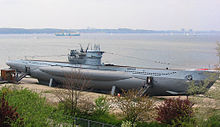
A light hull (casing in British usage) of a submarine is the outer non-watertight hull which provides a hydrodynamically efficient shape. The pressure hull is the inner hull of a submarine; this holds the difference between outside and inside pressure.
Modern submarines are usually cigar-shaped. This design, already visible on very early submarines is called a "teardrop hull", and was patterned after the bodies of whales. It significantly reduces the hydrodynamic drag on the sub when submerged, but decreases the sea-keeping capabilities and increases the drag while surfaced.
The concept of an outer hydrodynamically streamlined light hull separated from the inner pressure hull was first introduced in the early pioneering submarine Ictineo I designed by the Catalan inventor NarcÃs Monturiol in 1859. However, when military submarines entered service in the early 1900s, the limitations of their propulsion systems forced them to operate on the surface most of the time; their hull designs were a compromise, with the outer hulls resembling a ship, allowing for good surface navigation, and a relatively streamlined superstructure to minimize drag under water. Because of the slow submerged speeds of these submarines, usually well below 10 knots (19Â km/h), the increased drag for underwater travel by the conventional ship like outer hull was considered acceptable. Only late in World War II, when technology enhancements allowed faster and longer submerged operations and increased surveillance by enemy aircraft forced submarines to spend most of their times below the surface, did hull designs become teardrop shaped again, to reduce drag and noise. USS Albacore (AGSS-569) was a unique research submarine that pioneered the American version of the teardrop hull form (sometimes referred to as an "Albacore hull") of modern submarines. On modern military submarines the outer hull (and sometimes also the propeller) is covered with a thick layer of special sound-absorbing rubber, or anechoic plating, to make the submarine more difficult to detect by active and passive SONAR.